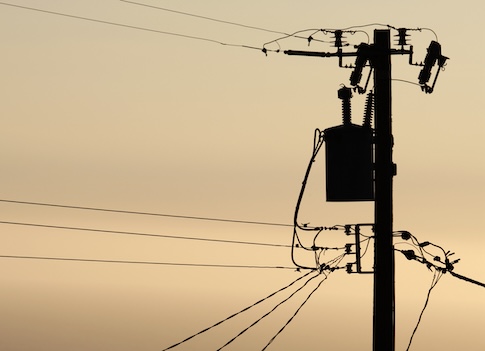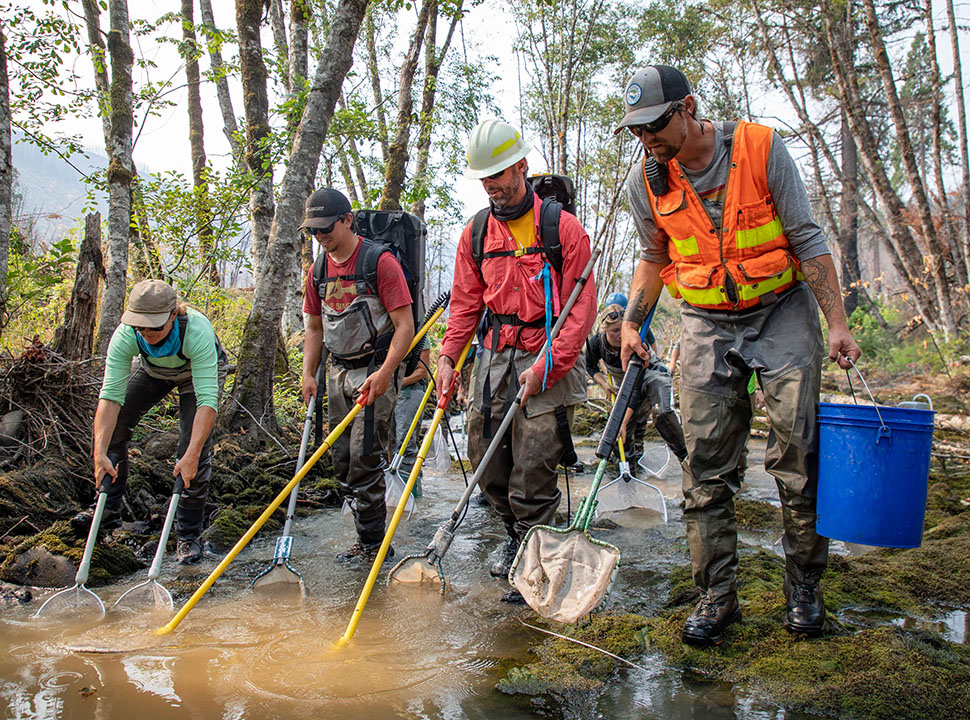Related News
Related News
-
September is National Preparedness Month: 3 tips to prepare your home & family
Let's "Be Ready" together!
Find Out More -
EWEB invests in preparedness for severe weather and natural disasters
Just as you take steps to safeguard your home and family, EWEB is investing in equipment and processes to ensure our community’s electric and water systems remain reliable in the face of adversity.
Find Out More -
EWEB prepares to re-energize the new Currin Substation
The rebuilt substation will increase load capacity, improve power reliability, and incorporate seismic resiliency to ensure service to our community for generations.
Find Out More -
Demand for EWEB electricity during heatwave nearly broke all-time summer record
Climate-driven weather extremes, home electrification, high-tech manufacturing and data centers will cause electricity demand to surge across the Pacific Northwest.
Find Out More -
EWEB explores rate increases to cover rising costs and to modernize infrastructure
Amid rising inflation and other challenges, rate increases are necessary to maintain reliable utility services and fund critical investments in Eugene’s water and electric infrastructure.
Find Out More -
EWEB preparing for expected surge in electric vehicles
Electric vehicle (EV) sales are poised to skyrocket in the years ahead as technology improves, more models hit the market, prices fall and regulations limit the sale of gas-powered vehicles. And EWEB is preparing for this surge.
Find Out More -
EWEB bids a fond farewell to College Hill Reservoir and prepares for modern drinking water storage tanks
Several hundred Eugene residents came together on May 30 for a Farewell Celebration at EWEB’s College Hill Reservoir before demolition and construction to build modern drinking water storage tanks begins later this year.
Find Out More -
EWEB invests in satellite-based forestry analytics for vegetation management
EWEB maintains over 1,300 miles of overhead transmission and distribution lines. To aid crews in identifying hazardous vegetation growth in a sometimes heavily forested service territory, EWEB is utilizing a new satellite-based forestry analytics software called Overstory.
Find Out More -
Tips to stay cool while saving money this summer
June is quickly approaching, and that means summer weather is just around the corner. Before you turn up the air conditioning and see an increase in your utility bill, try these tips to prepare your home for warmer weather to keep your home cool.
Find Out More -
EWEB offering additional energy efficiency supplement to qualified customers
Current EWEB residential electric customers may qualify to double their energy efficiency rebates with a limited time supplement.
Find Out More -
EWEB opens application for 2024 Electric Mobility Community Grants
Grant awards of up to $30,000 to cover costs associated with electric mobility projects.
Find Out More -
Upgrades to Eugene's downtown electric network continue
You may have noticed construction this week on the corner of 7th and Pearl Street. That’s because crews replaced a corroded, aging vault with an innovative, new Voltek vault. The Voltek design allows for the new infrastructure to be built inside of the existing aging vault. We’re able to install the new vault while the cables are still energized, minimizing disruption to customers and traffic while cutting construction time in half.
Find Out More -
The Big Freeze 2024: After Action Report
Winter 2024 was one for the records books, and we'll look back on it for years to come and say, "That was a doozy!" The back-to-back January Ice Storms caused widespread damage to EWEB’s service territory, affecting approximately 38,000 customers. Preliminary repair costs were over $8 million, and additional repairs to transmission lines are still required.
Find Out More -
Celebrate Earth Month by taking charge of your home's energy use
This Earth Month, learn how you can reduce your energy usage to help protect our planet and reduce carbon emissions.
Find Out More -
Spring Cleaning? How about Spring Emergency Preparedness!
Spring is officially here and that means the plants are blooming, the sun is (sometimes) shining, and the grass is green! We've had our fair share of severe weather already, but spring weather is notoriously unpredictable. While you're in the midst of spring cleaning and garden care, consider completing these emergency preparedness tasks.
Find Out More - Show More
EWEB prepares for rising energy demand as weekend heat wave arrives, and in the years ahead
July 01, 2024 • Aaron Orlowski, EWEB Communications

With daily high temperatures forecasted to surpass 100 degrees this weekend, EWEB is preparing for rising electricity demand as air conditioning units across Eugene struggle to keep pace with the oppressive heat.
The heat wave is the first volley in what will be a hotter-than-normal summer. For the rest of July, temperatures will be above average across much of the country, including the Pacific Northwest, according to the National Oceanic and Atmospheric Administration (NOAA).
EWEB has detailed procedures to always ensure a reliable supply of electricity. In real time, EWEB monitors overall customer demand and ramps electricity production up and down to meet that demand. In the short-term, EWEB buys and sells energy with other utilities to ensure sufficient energy supplies for the next day, next week and next month. And in the long term, EWEB is conducting ongoing energy resource analysis to see what mix of energy resources will best meet customers’ needs 20 years into the future.
For this heat wave, EWEB has set up its flexible resources to generate maximum output on demand when customers need electricity the most. Those flexible resources include EWEB’s Carmen-Smith Hydroelectric Project on the McKenzie River and part of EWEB’s allocation of the federal Columbia River hydropower system.
“EWEB is fortunate to have flexible resources – especially hydropower – that can ramp up and down to meet demand for electricity, even during broiling summer days and winter cold snaps,” said EWEB Chief Energy Resources Officer Brian Booth. “In the short term, we have sufficient supply to get through this heat wave. In the long term, we have a lot of work to do to make sure electricity demand doesn’t surpass supply and cause shortages.”
Weather drives demand for electricity. Hot weather will elevate the risk of blackouts in much the country this summer, including California and the desert Southwest, according to the North American Electric Reliability Corporation’s (NERC’s) 2024 Summer Reliability Assessment. The assessment states that the Northwest has enough resources to meet demand this summer.
But in the years ahead, the specter of electricity shortages looms, experts warn. As heat waves grow more frequent and weather grows more extreme, electric utilities will need to build additional electricity generation facilities to keep up with demand. If they don’t do so in the next 20 years, industry studies say, electricity shortfalls could occur, leading to rolling blackouts.
One study, conducted by the Western Electricity Coordinating Council (WECC), forecasts what would happen during a heat wave in the year 2042 if demand for electricity rises as expected and if buildout of new resources occurs as utilities are currently planning. In this “business as usual” future, a heat wave similar to the heat wave that struck in August 2020 will inflict blackouts on the Western U.S.
But other studies say shortages could arrive much sooner.
“Energy shortages in the Western U.S. are a real threat in the future,” Booth said. “Electricity demand is rising. More people are installing air conditioning and electric heating and electric vehicle charging. More data centers are arriving to support artificial intelligence. More industrial customers are switching to electricity. If we don’t build enough new electricity generation facilities to keep pace with demand, then there will be shortfalls.”
Electricity demand in the Pacific Northwest forecasted to rise 30% in the next 10 years
Data centers, high-tech manufacturing, electrification of heating and cooling, and adoption of electric vehicles will cause demand for electricity in the Pacific Northwest to climb 30% in the next decade, according to the Pacific Northwest Utilities Conference Committee’s (PNUCC’s) 2024 regional forecast, which was published in May. The report compiles the demand forecasts of utilities across the Northwest into one comprehensive number.
This surge in electricity demand is the equivalent of adding about seven cities the size of Seattle to the Northwest power grid. And the demand forecast is likely on the low end: It doesn’t include some demand from data centers that large tech companies are building.
While Northwest utilities continue to add new resources to replace the retirement of carbon-emitting resources, they haven’t done so at a rate sufficient to meet anticipated demand, the report says.
In the next 10 years, if utilities don’t build any new resources, then the region will face massive shortages of electricity on the hottest summer days and the coldest winter days. The report forecasts a deficit of 13,700 megawatts in the next decade in both summer and winter if demand rises as expected and if utilities don’t build any additional resources.
“While individual utilities have unique needs, there is a shared commitment to collaboration in developing an unprecedented amount of new generation in the next 10 years,” PNUCC Executive Director Crystal Ball said in a statement. “This will require intense coordinated planning along with strong public support to assure an adequate, reliable power supply during the region’s transition to a cleaner energy future.”
Shortages could arrive as soon as 2027 in the Pacific Northwest
Another study says those shortages could arrive in just a few years, if the region doesn’t take action.
If the Pacific Northwest does not build any additional new energy resources, the region faces a nearly 50% chance of blackouts at some point in 2027 due to insufficient energy, according to a new report published by the Northwest Power and Conservation Council (NWPCC).
In stark terms, the report makes clear that the region’s current power supply will not be enough to meet demand in 2027, if the region tries to rely solely on existing resources. Instead, the report says, the region needs to obtain at least the amount of energy outlined in NWPCC’s 2021 Power Plan.
The new report finds that if the region follows the 2021 Power Plan resource strategy and builds a large number of new resources, it will effectively eliminate nearly all potential shortfalls of energy during the summer. But acquiring the resources suggested in the 2021 Power Plan still won’t be sufficient to eliminate winter shortfalls, when there may not be enough energy to meet needs during certain hours on the coldest days of the year.
Market dynamics and new policies are likely to make the need for new resources even greater.
“If future electricity market supplies are significantly limited, if new policy commitments to electrification accelerate demand growth, or if major resources are retired earlier than expected without replacement, then additional resources and reserves will be required to maintain system adequacy,” the report says.

Customer participation will be vital to meeting future needs
Utilities, including EWEB, will need to either procure new sources of electricity that they can call upon on a moment’s notice to generate more power, or find ways to pare back electricity demand when it’s at its highest.
Last summer, during the August heat wave that saw temperatures crest 100 degrees for four days straight, EWEB called on customers to voluntarily trim their energy usage in the late afternoon and evening hours to avoid straining the grid.
Customers responded by raising the setting on their thermostats a couple degrees and delaying usage of major appliances until overnight, ultimately shaving energy usage by 10 to 15 megawatts during certain hours, or the equivalent of shutting off 10,000 to 15,000 window air conditioning units across Eugene.
Since then, EWEB has been studying instituting formalized “demand response” programs that would reward customers for cutting energy usage at peak times. Specifically, EWEB is analyzing what types of programs will yield the most energy savings for the investment and which will have the highest potential adoption rates.
“During the 2023 heat wave, we had a tremendous response from our community. People rallied together to cut back energy usage when we needed to and achieve something that no one could have done alone,” Booth said. “The enthusiasm makes me excited to see how demand response programs can play an increasingly important role in our efforts to better align electricity demand with supply.”
What you can do to save energy:
A cleaner energy future requires modernizing our power grid and water network.
By understanding the differences between your options, you'll be able to make a confident, informed decision that aligns with your values, budget and needs.




